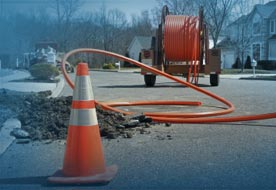
 It’s easy to forget that the virtual reality of the Internet depends on the gritty reality of wires hung on utility poles, wireless signals carried by antennas and receivers on towers and fiber buried under streets and railroad rights-of-way. But the cost of reaching consumers and businesses with broadband Internet access depends in no small part on the time and expense required to string wires on poles and dig under streets.
It’s easy to forget that the virtual reality of the Internet depends on the gritty reality of wires hung on utility poles, wireless signals carried by antennas and receivers on towers and fiber buried under streets and railroad rights-of-way. But the cost of reaching consumers and businesses with broadband Internet access depends in no small part on the time and expense required to string wires on poles and dig under streets.
To reduce costs and delays, the FCC is working to reform infrastructure policies through its Broadband Acceleration Initiative. The goal: help broadband providers get robust, affordable wired and wireless broadband everywhere. Today, that initiative bore fruit when the FCC approved real reform in the arcane world of pole attachments.
Consider this: some communications companies report that it can take many months or even years for utility companies to do the work necessary for broadband providers to attach their wires or antennas to utility poles. Wireless providers, for example, report that faster and more predictable attachments could save them over $5 billion – money that could be better spent on deploying and upgrading broadband for consumers across the country. So today we adopted rules that will make expanding and improving broadband networks faster, cheaper and more predictable.
Or consider that, under current rules, while a cable company may pay $7 a foot per year to attach its wire to a pole, a telephone company may pay $20 or more. It might seem odd in this world of converging communications, where your cable company may sell phone service and your phone provider sells pay TV service. So we reduced the disparity in rates between different types of companies for the same attachments. It will still fairly compensate utilities. But now, for example, cable companies won’t jeopardize their low rate by providing new telecommunications services, and phone companies will find it cheaper to expand and improve broadband networks.
We also launched a broad effort to improve rights-of-way and wireless facility access policies. We’re asking all our partners in government – state, local, Tribal, and federal – and industry for a lot of information. Are rates for access reasonable? How do access policies affect the broader economy? Have access policies kept up with new technologies such as microcells, femtocells and distributed antenna systems that can improve wireless broadband? The responses will help us figure out what we should do to facilitate access and encourage broadband facilities deployment.
Pardon the dust: major construction zone ahead. Improvements coming soon!